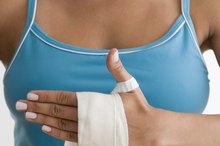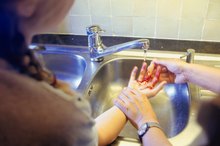How to Tell If a Suture Scar Is Healing Well
Sutures are used to keep surgical or trauma wound edges together while the skin heals from the inside out. They allow for decreased infection rates and increased healing. Sutures are made of absorbable or non-absorbable materials; for the purpose of this article only sutures made of non-absorbable materials are mentioned. Do not remove surgical wound dressings until advised to do so by a physician or health care provider.
Wash hands thoroughly before and after touching the wound to prevent infection. Wet hands with warm water and lather for at least 20 seconds. Rinse, then dry on a disposable towel.
How to Dry Out Wounds
Learn More
Remove old bandages once advised to do so by the physician; dispose of them immediately. Cleanse the affected area using warm water and an antibacterial soap on a disposable cloth. Rinse with fresh water and a clean cloth. Repeat this step as necessary until all dried blood and secretions are removed, but be careful not to rub too vigorously. If the surgical dressings are no longer present, proceed to Step 3.
Look at the scar and give special attention to the edges, or where the skin healed together from the wound. A suture scar that is healing well should not have any drainage, open areas, redness or blisters. The holes on either side of the wound edge represent the suture marks and should be healing, devoid of redness, drainage or swelling 5.
How to Use a Tegaderm
Learn More
Touch the area surrounding the wound gently. Warmth, pain and swelling are abnormal findings and do not indicate a well healing suture scar. Bruising may be normal, although bruising with raised, palpable borders is an abnormal finding.
Probe along the borders of the suture line gently, using a clean cotton swab. If the borders are approximated, or touching in all areas, this is a sign of a healing suture scar. Gaps or open areas are abnormal findings and must be reported to the physician. Eventually this line will become the actual scar and should fade to a pink, white or tan line dependent upon skin color.
Tips
Itching is a normal finding along a well-healing suture line.
Related Articles
References
- How should I care for my stitches? (2017).
- Stitches. (2014).
- Surgical site infections. (n.d.).
- Suture care. (n.d.).
- Wound healing and care. (2015).
- Mccaughan D, Sheard L, Cullum N, Dumville J, Chetter I. Patients' perceptions and experiences of living with a surgical wound healing by secondary intention: A qualitative study. Int J Nurs Stud. 2018;77:29-38. doi:10.1016/j.ijnurstu.2017.09.015
- Krafts KP. Tissue repair: The hidden drama. Organogenesis. 2010;6(4):225-33. doi:10.4161/org.6.4.12555
- Chetter IC, Oswald AV, Fletcher M, Dumville JC, Cullum NA. A survey of patients with surgical wounds healing by secondary intention; an assessment of prevalence, aetiology, duration and management. J Tissue Viability. 2017;26(2):103-107. doi:10.1016/j.jtv.2016.12.004
- Singh PK, Saxena N, Poddar D, et al. Comparative Study Of Wound Healing In Primary Versus Delayed Primary Closure In Contaminated Abdominal Surgery. Hellenic J Surg. 2016;88:314–320. doi:10.1007/s13126-016-0340-8
- Surgical Patient Education Program: Prepare for the Best Recovery. American College of Surgeons. 2018.
- Rushbrook JL, White G, Kidger L, Marsh P, Taggart TF. The antibacterial effect of 2-octyl cyanoacrylate (Dermabond®) skin adhesive. J Infect Prev. 2014;15(6):236-239. doi:10.1177/1757177414551562
- Lazar HL, Mccann J, Fitzgerald CA, Cabral HJ. Adhesive strips versus subcuticular suture for mediansternotomy wound closure. J Card Surg. 2011;26(4):344-7. doi:10.1111/j.1540-8191.2011.01257.x
- 3M Wound Resource Center. http://solutions.3m.co.uk/wps/portal/3M/en_GB/skin-care/wound-resource-centre/
Writer Bio
As a bachelor's-prepared registered nurse with more than 15 years of diversified experience, Juliet Wilkinson innerves our health-conscious population through expert articles. She is a motivated professional who believes that preventive care is the first step towards health and well-being.






